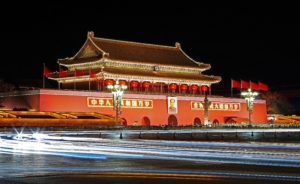
It’s hard to believe that in the year 2001 when the 21st Century began, most people still thought that China was a country filled with starving peasants. When I packed my bags to move to Hong Kong that January, the world had still not awoken to the fact that China had already spent 22 years coming out of extreme poverty and a disasterously planned economy. Chinese products were cheap and of poor quality and China’s futuristic cities and high-speed trains were still not images people associated with “Communist Red China.” Meanwhile, the United States was viewed as the indisputed sole, remaining Superpower after the collapse of the Soviet Union in 1991. The U.S. “dot-com boom” was getting underway and the world was about to consume American high-end products and Chinese low-end products for the next 20 years. As a new middle-class emerged in Developing Countries and the world economy grew at unprecedented speed, no two countries dominated the world like China and the United States who used globalization to develop an informal but mutually beneficial interdependent partnership coined as “Chimerica.” Both countries now find themselves as the indisputed Kings of Globalization. Ironically, they both find themselves literally bankrupt–as in, insolvent. Their victory was pyrrhic and both country’s economies are now going to be exposed as houses of cards. In a further twist, both are dealing with the crisis by becoming centrally planned economies; one planned by the Chinese Communist Party and the other by the Federal Reserve working with the U.S Treasury. This is a twist not even the best science fiction writers could have predicted. China and the USA are turning into each other: Dysfunctional, dystopian hyper-capitalist nations running on Socialism.
China’s middle class has grown bigger and faster than any in the history of the world. The average Chinese went from maybe owning a bicycle in the 1980’s to owning an apartment and a car, while the average American bought more houses and tech gadgets, took on more debt and saw their wages stagnate. Both countries saw their people become addicted to buying things on credit and taking on debt. The West began outsourcing their jobs to China and China began to use that money to invest in the greatest expansion of infrastucture the world has ever seen. They also used that money to buy favor through loans and infrasture in developing countries. There is now a high-speed rail from Nairobi to Mombassa thanks to the Chinese. Many countries including Costa Rica got new soccer stadiums. Some countries got ports and many countries got their first freeways courtesty of Chinese laborers. Housing prices in some of the poorest countries in the world like Angola and Zambia started to catch up to the sky-rocketing prices in places like Sydney, New York and London as the Chinese moved in to find natural resources. By the early 2000’s, China had built up a $4 trillion sovereign wealth fund–money they could use for a rainy day.
2008: Day of Reckoning #1: The Global Financial Crisis and the USA
Meanwhile, the U.S. went on a spending spree. By refusing to tax, by never balancing the budget because “deficits don’t matter,” by having undisciplined policies enacted by Alan Greenspan and Ben Bernake at the Federal Reserve, through trillions spent on Homeland Security after 9/11 and $7 trillion put on a credit card to pay for the War on Terror; by 2008 the United States (and the world) had a financial meltdown. With the U.S. government now facing a total collapse, banks refusing to lend and consumers not buying, the only alternative in 2008 was for government to spend and to take on debt and rescue “too big to fail” corporations. But unlike China, the U.S. entered into the 2008 crisis already bankrupt.
Having created a stock-market bubble, and a property bubble, now the U.S. was committed to either letting the whole thing collapse or take on more government debt to artificially inflate the U.S. markets. Low interest rates, government money and low taxes (particularly for the wealthy) re-inflated the stock and property markets. It was a house of cards, but one that could have gone on another decade or so. Then Covid-19 hit and the U.S. already financing itself with debt was going to have to print trillions of dollars to pay for this next economic crisis. That is what has happened. Pretty soon, the Federal Reserve was directly buying Apple stock and working closely with the Treasury to give the illusion of a “booming economy” as the stock market “hit new highs.” The reality was that just like China, the U.S. has become a centrally planned economy. From the 2000’s, the United States became socialist like China, except only for wealthy corporations. But after Covid, now the United States is a planned central-economy for rich and poor alike. The moment when all of this could have been prevented preceeded the Biden, Trump, and Obama years. It was early in the 2000’s during Bush’s first years in office that this kind of “kicking the can down the road” mentality could have been avoided. The free-markets were no longer allowed to work and debt and artificially created bubbles became the rule of the U.S.A.
China on the other hand, pretty much sailed through 2008. While Europe, Latin America, much of Asia, and North America struggled to recover from 2008; China continued with it’s 7%+ annual growth in GDP. Chinese companies like Huawei and Alibaba became global brands, and China’s “One Belt, One Road” project began to economically re-connect Eurasia through infrastructure in what is meant to be the 21st Century Silk Road. Good times, right? Nope. China managed to screw that up.
2020: Day of Reckoning #2: The Covid Economic Meltdown
The Covid-19 virus which originated in China brought a halt to China’s days of 7% growth (although they may have a good year this year because they are starting from such a low position). While wages stagnated in the West, they went up in China. They went up so much that Chinese factories were now being moved to Vietnam, Sri Lanka and Bangladesh. China now faced a few enormous problems: 1) a massive financial debt 2) A Reminbi trap due to its manipulated currency 3) A demographic challenge with more retirees than they can support 4) A middle-income trap where they are not able to raise their per capita GDP much more and 5) A loss of goodwill and trust around the world after spending trillions to buy people’s love and loyalty.
Even prior to 2020, China was a nation that had built-up its nation with debt and bad loans. For every fancy freeway, train, or skyscraper, there were hundreds of phony projects that left banks reeling and the Chinese government fudging the numbers. Of the world’s $300 Trillion of (totally unpayable and unprecedented) debt, 70% of it belongs to the USA and China. China’s ratio of debt to GDP was over 300% before Covid hit. Both China and the USA carry debt level to GDP ratios that are like Greece or the worst-managed Third World countries from the 1970’s. And these guys were the winners!!
The End Game: Now What?
Neither the USA or China are Zaire, Venezuela, or even Russia. Both countries have enough staying power to avoid being nations in extreme hyper-inflation where it takes a wheel-barrel of money to buy a carton of milk. Both the United States will continue to see their middle classes disappear, their global influence wane, and both will see their currencies devalue as the world seeks more stability than the Dollar and Yuan can offer. Both countries will continue becoming Capitalist/Socialist hybrids that flirt with authoritarianism and Nationalism. And both countries will use each other to threaten military action and assert their position as Global “Superpowers.”
Both countries will choose robotics and artificial intelligence to drive their economies leading toward more pressure on people lacking in tech skills and higher education. Both countries will see alliances around the world form to counter-balance the inherent instability of these two reckless superpowers. Expect more regionalism in this new multi-polar world. The US will continue to spend the next decade threatening Civil War against itself, while China spends the next decade building the world’s most sophisticated surveillance society (which could backfire and start a civil war there).
Eventually, a new tech revolution will begin to re-invent the global economy and bring massive disinflation. Some form of a currency re-set will take place that leaves the Dollar and the Yuan more on the sidelines. And both countries will move toward a hybrid-economy model that protects the worker, enables high-tech companies and robots to flourish, and which looks more like the Scandanavian model than the Reagan/Thatcher model or the Mao Zedong model. But the amount of displacement, poverty, and conflict that it will take to get there will be significant. Through it all, we have to hope that neither the USA or China seek to distract their populations by going to war with each other. It would not need to be a military conflict, it could be cyber-warfare, or a war on the aritifical intelligence front.
The tragedy is that none of this had to happen. China could have managed its books better and trusted its citizens more. It could have chosen a road other than the retro-authoritariansim of President Xi. It did not, so now it is a fragile house of cards. The United States could have embraced balanced budgets, less Federal Reserve intervention, more taxation, less endless wars, and allowed reckless corporations and banks to fail. But it did not. Now the world must watch closely for the next 10 years as these two spoiled, reckless superpowers try to dig themselves out of a massive hole they created for themselves and everyone else. Let’s hope somewhere in Beijing and Washington, some lessons have been learned.
